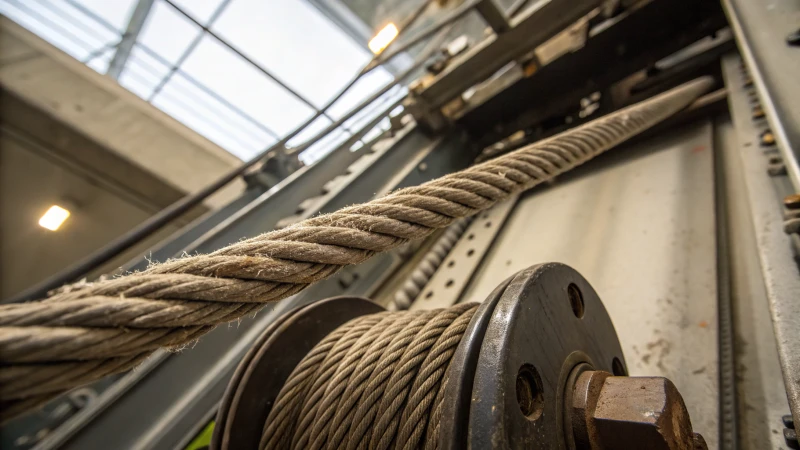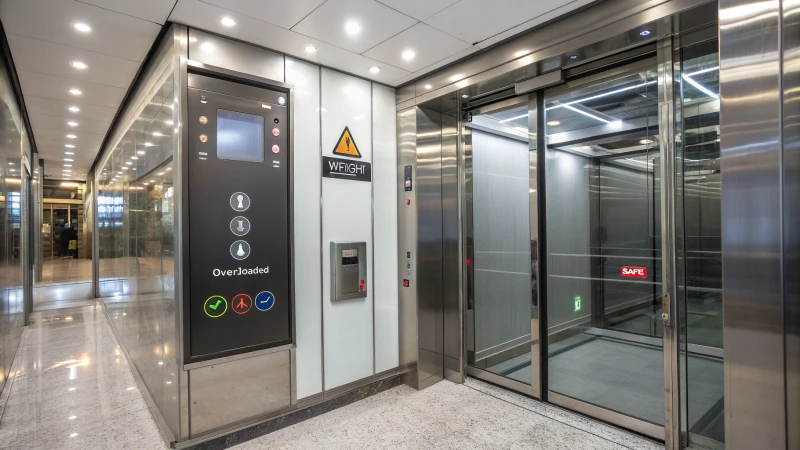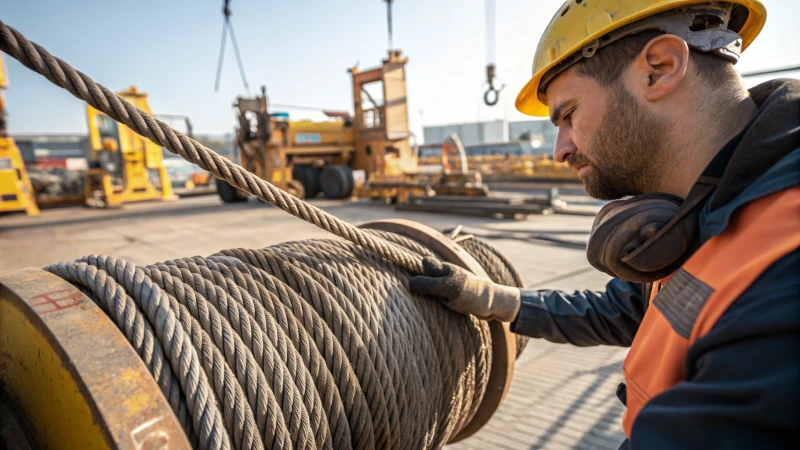
Imagine stepping into an elevator, blissfully unaware of the intricate dance of steel wire ropes ensuring your safe journey.
Overloading steel wire ropes in elevators can lead to deformation and increased wear, which jeopardizes their safety and performance. According to ISO 18146, it's crucial not to exceed 1/5 to 1/3 of the rope's breaking strength to maintain optimal function and safety standards.
When I first learned about the importance of maintaining proper loads in elevators, it was a bit of a revelation. Just like how wearing shoes that are too tight can make walking uncomfortable, overloading these ropes can stretch them beyond their limits. The ropes might start to show signs of wear and tear, reducing their lifespan and potentially causing safety issues. It’s a gentle reminder that everything has its limits—even something as tough as steel.
To ensure the longevity and reliability of these ropes, regular inspections and adhering to the recommended load limits are non-negotiable. With technology advancing, modern elevators are equipped with load monitoring systems that can help us keep things in check. These systems are like having a vigilant friend who always has your back, ensuring nothing goes awry. It's all about striking the right balance between demand and capacity to keep those elevators running smoothly and safely.
Overloading can cause steel wire ropes to stretch.True
Stretching occurs due to excessive load, reducing rope safety.
ISO 18146 allows exceeding the rope's breaking strength.False
ISO 18146 specifies not to exceed 1/5 to 1/3 of breaking strength.
What Are the Common Signs of Steel Wire Rope Overload in Elevators?
Ever wondered how to spot the telltale signs of elevator wire rope overload before it’s too late?
Look out for visible deformation, unusual stretching, fraying, increased wear, and odd creaking or snapping sounds in steel wire ropes. Regular check-ups can catch these signs early, ensuring safety and longevity of the elevator system.

Visible Deformation and Stretching
It's like when you wear your favorite sweater too many times and it starts to sag in odd places—that's what happens to steel wire ropes under overload. I remember once seeing ropes that were kinked and bent out of shape. They looked stretched thinner than they should've been, much like an old rubber band on its last stretch. Those ropes were screaming for attention. Regular inspections are crucial; it's like going to the dentist—catching cavities early saves the tooth. If you spot these signs, it's time to investigate further1 and call in a pro.
Fraying and Increased Wear
Imagine unraveling the yarn on a cozy knit blanket, strand by strand—that's fraying. I’ve come across ropes that looked like they’d been through a shredder, with strands coming loose. It's not just a sign of age but of overwork. A rope under too much pressure is like us trying to juggle too many things at once—something's bound to snap eventually.
A comparison table of frayed vs. healthy ropes:
| Condition | Appearance |
|---|---|
| Frayed | Strands unraveled, ends exposed |
| Healthy | Strands tightly wound, no exposure |
Audible Creaking or Snapping Sounds
Ever heard a haunted house creak at night? Elevators can make those sounds too when ropes are overloaded. That eerie creaking or snapping is a warning that the ropes are at their limit—it's like listening to a whispered cry for help. If your elevator starts making these noises, it’s time to listen closely and act fast.
Monitoring Systems and Load Limits
These days, elevators are pretty smart, thanks to load monitoring systems. They’re like having a personal trainer who warns you before you lift too much and pull a muscle. Understanding these systems can save a lot of headaches.
A load monitoring system can provide real-time data, ensuring that the elevator operates within safe parameters. Consult your elevator's manual for specific load limits because staying within these limits is as crucial as not overfilling your favorite coffee mug—you don’t want a spill.
For more insights on load monitoring technologies, check out advanced systems2 available on the market today.
Visible deformation indicates steel wire rope overload.True
Visible deformations like kinks or bends suggest the rope is overloaded.
Fraying is a sign of proper steel wire rope maintenance.False
Fraying indicates wear and potential overload, not proper maintenance.
How can load monitoring systems prevent elevator overloading?
Imagine stepping into an elevator, feeling secure knowing that a system is in place to ensure your safety by preventing overloading.
Load monitoring systems in elevators prevent overloading by using sensors to measure the weight inside the cabin. These systems alert users or stop the elevator if weight limits are exceeded, ensuring safety and compliance with regulations.

Understanding Load Monitoring Systems
When I first learned about load monitoring systems in elevators, I was intrigued by how these little marvels work tirelessly to keep us safe. Picture this: you're in an elevator, maybe with a few friends or carrying some luggage, and you don't give a second thought to whether it's safe to ride. That's the beauty of load monitoring systems—they silently measure the weight inside the elevator cabin using sensors. These sensors detect everything from people to packages and make sure the total weight doesn't exceed safe limits. If it does, the system will either alert us or even stop the elevator from moving, safeguarding its structural integrity3 and prolonging its lifespan.
Types of Load Monitoring Systems
I find it fascinating how different technologies are employed in these systems. There are several types of sensors, like strain gauges, load cells, and pressure sensors, each bringing its unique strengths to the table.
| Sensor Type | Advantages | Applications |
|---|---|---|
| Strain Gauge | High precision and reliability | Passenger elevators |
| Load Cell | Converts force into electrical signals; robust | Industrial applications |
| Pressure Sensor | Measures pressure exerted by the load | Smaller, cost-effective solutions |
Strain gauge sensors are all about precision, measuring deformation under stress, which is why they're often used in passenger elevators. On the other hand, load cells convert force into electrical signals and are built to withstand industrial use—imagine them as the workhorses of elevator safety. Then there are pressure sensors, which are more cost-effective and perfect for smaller applications. Choosing the right sensor depends on the specific needs of the elevator system.
Benefits of Implementing Load Monitoring Systems
The benefits of these systems are quite impressive. First and foremost, they enhance safety by preventing potential overloading situations4 that could lead to accidents. This reassurance is invaluable, knowing that elevators operate within safe weight limits. It doesn't just stop there; load monitoring systems also contribute to the longevity of an elevator's components by reducing wear and tear. Plus, they help ensure compliance with safety standards—something we all rely on for peace of mind.
Challenges in Load Monitoring System Implementation
Of course, implementing these systems isn't without its hurdles. One major challenge is ensuring the sensors are calibrated correctly to reflect true load conditions—it's a bit like making sure your bathroom scale is accurate every time you step on it. Regular calibration is crucial for accuracy. Then there's the task of integrating these systems into existing elevator designs without causing too much disruption—nobody wants an elevator out of service for long! And let's not forget about potential system malfunctions5 that might cause false alerts or failures, necessitating ongoing maintenance and monitoring.
For those interested in diving deeper into the technology behind these systems and their broader implications, exploring more on elevator technology6 can provide valuable insights.
Load monitoring systems prevent elevator overloading.True
These systems alert or stop elevators when weight limits are exceeded.
Strain gauge sensors are used for industrial elevators.False
Strain gauge sensors are typically used in passenger elevators for precision.
How Can I Extend the Life of Steel Wire Ropes?
Ever wonder how those mighty steel wire ropes in construction and mining withstand so much? Their longevity isn't just about strength—it's about smart maintenance.
To extend the life of steel wire ropes, focus on regular inspections, proper lubrication, avoiding overloading, and correct storage. These practices help detect wear early and maintain performance.

I remember the first time I was tasked with ensuring the longevity of steel wire ropes for a big construction project. It was a bit daunting, to be honest. But I quickly learned that a little proactive maintenance could save a lot of headaches and money down the road.
Regular Inspection
Picture this: you're heading out for a morning run and notice your shoelace is fraying. You'd fix it before tripping, right? It's similar with steel wire ropes. Regular inspection is like checking those laces. I'm always on the lookout for kinks, corrosion, or frayed strands—those telltale signs that things might go awry. Here's a handy checklist I use:
Inspection Checklist:
| Aspect | What to Check |
|---|---|
| Surface | Corrosion or rust |
| Strands | Broken wires |
| Lubrication | Dry or sticky areas |
By identifying these issues early, you can prevent costly equipment failures7.
Proper Lubrication
Back when I first got into this field, someone told me to think of lubrication as the 'secret sauce' for steel wire ropes. It's true! Lubrication is crucial to reducing friction and extending lifespan. Use a lubricant that meets the manufacturer's specifications to avoid damaging the rope. Trust me, applying it evenly can make all the difference in ensuring optimal performance8.
Avoiding Overloading
One lesson I learned early on is that overloading isn't just risky—it's costly. It's like trying to carry all the groceries in one trip; sure, it seems efficient until something breaks. Always adhere to the rope's rated capacity and use load monitoring systems to maintain loads within safe limits and prevent overloading9.
Correct Storage
Storing these ropes correctly is another biggie. Imagine leaving your best winter coat in a damp basement all summer—it wouldn't last long. Steel wire ropes need a dry, cool space, away from harsh chemicals.
Use reels or spools to keep them tangle-free.
Storage Tips:
- Use protective covers
- Rotate stock regularly
- Keep away from direct sunlight
Specialized Equipment
Finally, investing in specialized equipment like wire rope testers has been invaluable for me. It’s like getting an X-ray for the ropes, helping detect internal flaws before they become problems.
This non-destructive testing method can identify internal flaws that might not be visible externally.
By sticking to these practices, I've not only extended the lifespan of the ropes but also improved safety on-site. It's rewarding to see how these efforts contribute to smoother operations in industries like construction and mining.
For those wanting more detailed guidance, I recommend checking out resources from industry leaders—they offer comprehensive support and technical insights10 that are incredibly helpful.
Regular inspection can prevent costly equipment failures.True
Inspections identify issues like corrosion early, preventing failures.
Overloading steel ropes enhances their lifespan.False
Overloading causes stress and damage, reducing rope lifespan.
Why Is It Important to Follow Manufacturer Specifications for Load Limits?
Have you ever wondered why those load limit labels are so crucial? They could be your equipment's best friend and your safety net, all rolled into one.
Following manufacturer specifications for load limits is vital to prevent equipment failure, boost safety, and ensure adherence to industry standards. These guidelines protect both the machinery and those who operate it.

Understanding Load Limits
I remember the first time I was in charge of a major construction project. I was a bit overwhelmed by all the safety protocols, especially the ones regarding load limits. Load limits are basically the weight boundaries your equipment can safely handle, kind of like how much luggage your car can carry without risking a breakdown. Manufacturers set these limits after rigorous testing11 and engineering assessments, ensuring that exceeding them doesn't lead to dangerous malfunctions that could jeopardize both safety and productivity.
The Consequences of Overloading
Overloading equipment can be as risky as piling your car trunk with heavy suitcases and hoping for the best. It can cause structural damage and accelerate wear12 on components, leading to catastrophic failures. Imagine the steel wire ropes in an elevator stretching under too much pressure—they deform, and suddenly, you’re faced with a compromised system that’s unsafe and unreliable.
| Issue | Potential Consequences |
|---|---|
| Overloading | Equipment failure |
| Wear & Tear | Reduced lifespan of components |
| Structural Damage | Safety hazards |
Safety Regulations and Compliance
Sticking to load limits is not just about protecting equipment; it's also about playing by the rules. Industry regulations, like ISO 18146, exist to keep everyone safe. During my routine checks and maintenance rounds, I’ve realized how crucial it is to regularly inspect for any deviations from these set standards to prevent unforeseen mishaps.
Monitoring Systems: A Solution
The tech-savvy side of me loves how modern solutions like load monitoring systems and weight sensors come into play. They provide real-time data on load conditions, helping in preventive measures13 and planning maintenance before things go south. This tech has saved me numerous headaches over time.
Manufacturer Specifications: A Non-negotiable Aspect
Every piece of equipment is designed with specific load capacities for optimal performance. It's like a user manual for getting the most out of your gear without voiding warranties or facing liabilities14 during equipment failure incidents. By sticking to these guidelines, we not only maintain machinery integrity but also ensure a safe working environment for everyone involved. It's amazing how following these specs can prevent accidents and ensure operations run smoothly.
Exceeding load limits can void equipment warranties.True
Ignoring load specifications may void warranties, increasing liability.
Load monitoring systems eliminate all risks of overloading.False
They reduce risks but cannot eliminate all potential overloading hazards.
Conclusion
Overloading steel wire ropes in elevators compromises safety and performance, leading to deformation and wear. Adhering to load limits and regular inspections are essential for longevity and reliability.
-
Discover methods for examining and diagnosing deformation in elevator wire ropes. ↩
-
Find out about modern systems that help prevent elevator overloads. ↩
-
Understanding how load affects elevator components helps highlight the importance of maintaining structural integrity. ↩
-
Learn about the potential risks involved with overloading elevators to appreciate safety measures. ↩
-
Exploring common system issues helps in planning preventive maintenance for reliable operations. ↩
-
Stay updated with advancements in elevator technology for improved safety and efficiency. ↩
-
This link provides visual guides to identify wear signs in wire ropes, enhancing your ability to spot issues early. ↩
-
Explore recommended lubricants specifically designed for steel wire ropes to ensure longevity and performance. ↩
-
Learn about load monitoring systems that prevent overloading and extend the life of steel wire ropes. ↩
-
Access expert advice on advanced maintenance techniques for steel wire ropes. ↩
-
Discover how manufacturers determine load limits through rigorous testing processes. ↩
-
Learn how overloading impacts the longevity of machinery components. ↩
-
Understand how load monitoring systems can prevent overloading incidents. ↩
-
Explore the legal risks associated with ignoring manufacturer guidelines. ↩

